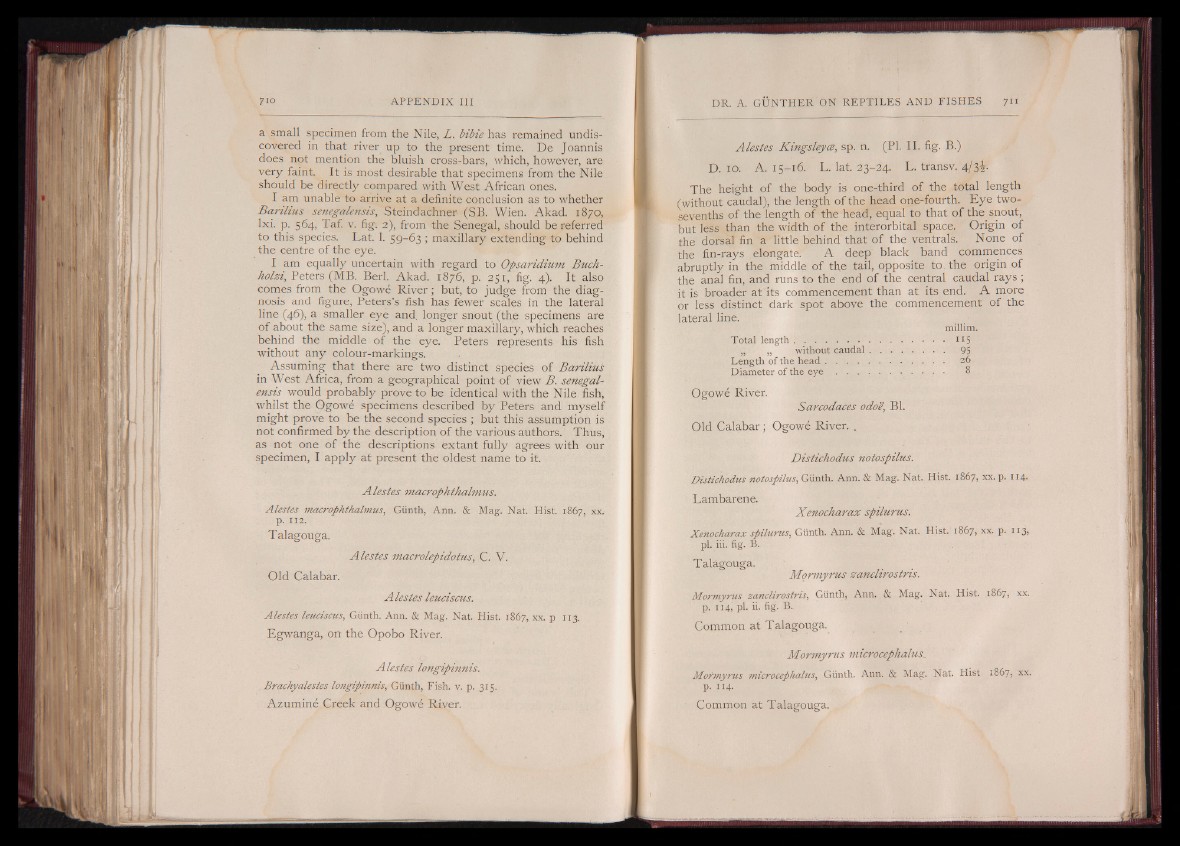
a small specimen from the Nile, L. bibie has remained undiscovered
in that river up to the present time. De Joannis
does not mention the bluish cross-bars, which, however, are
very faint. It is most desirable that specimens from the Nile
should be directly compared with West African ones.
I am unable to arrive at a definite conclusion as to whether
Barilius senegalensis, Steindachner (SB. Wien. Akad. 1870,
Ixi. p. 564, Taf. v. fig. 2), from the Senegal, should be referred
to this species. Lat. 1. 59-63 ; maxillary extending to behind
the centre of the eye.
I am equally uncertain with regard to Opsaridium Buch-
holzi, Peters (MB. Berl. Akad. 1876, p. 251, fig. 4). It also
comes from the Ogowe River; but, to judge from the diagnosis
and figure, Peters’s fish has fewer scales in the lateral
line (46), a smaller eye and. longer snout (the specimens are
of about the same size), and a longer maxillary, which reaches
behind the middle of the eye. Peters represents his fish
without any colour-markings.
Assuming that there are two distinct species of Barilius
in West Africa, from a geographical point of view B. senegalensis
would probably prove to be identical with the Nile fish,
whilst the Ogowe specimens described by Peters and myself
might prove to be the second species ; but this assumption is
not confirmed by the description of the various authors. Thus,
as not one of the descriptions extant fully agrees with our
specimen, I apply at present the oldest name to it.
Alestes macrophthalmus.
Alestes macrophthalmus, Gunth, Ann. & Mag. Nat. Hist. 1867, xx.
p. 112.
T alagouga.
Alestes macrolepidotus, C. V.
Old Calabar.
Alestes leuciscus.
Alestes leuciscus, Gunth. Ann. & Mag. Nat. Hist. 1867, xx. p 113.
Egwanga, on the Opobo River.
Alestes longipinnis.
Brachyalestes longipinnis, Gunth, Fish. v. p. 315.
Azumine Creek and Ogow6 River.
Alestes Kingsleyce, sp. n. (PI. II. fig. B.)
D. 10; A. 15-16. L. lat. 23-24. L. transv. 4/3^.
The height of the body is one-third of the total length
(without caudal), the length of the head one-fourth. Eye two-
sevenths of the length of the head, equal to that of the snout,
but less than the width of the interorbital space. Origin of
the dorsal fin a little behind that of the ventrals. None of
the fin-rays elongate. A deep black band commences
abruptly in the middle of the tail, opposite to . the origin of
the anal fin, and runs to the end of the central caudal rays ;
it is broader at its commencement than at its end. A more
or less distinct dark spot above the commencement of the
lateral line.
millim.
Total length .................................115
,; „ without caudal............................ 95
Length of the h e a d ............................................. 26
Diameter of the eye . .................................... 8
Ogowe River.
Sarcodaces odoe, Bl.
Old Calabar; Ogowe River. .
Distickodus notospilus.
Distichodus notospilus, Gunth. Ann. & Mag. Nat. Hist. 1867, xx. p. 114.
Lambarene.
Xenocharax spilurus.
Xenocharax spilurus, Gunth. Ann. & Mag. Nat. Hist. 1867, xx. p. 113?
pi. iii. fig. B.
Talagouga.
Mormyrus zanclirostris.
Mormyrus zanclirostris, Gunth, Ann. & Mag. Nat. Hist. 1867, xx.
p. 114, pi. ii. fig. B.
Common at Talagouga.
Mormyrus microcephalusjjj
Mormyrus microcephalus, Gunth. Ann. & Mag. Nat. his t 1867, xx.
p. 114.
Common at Talagouga.